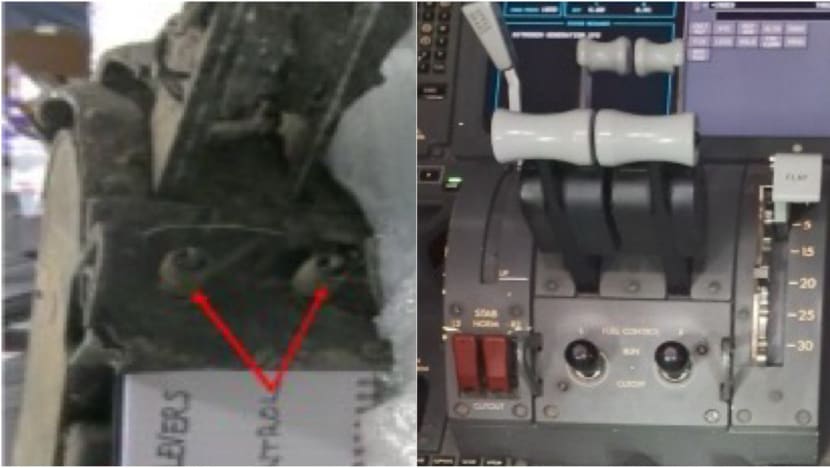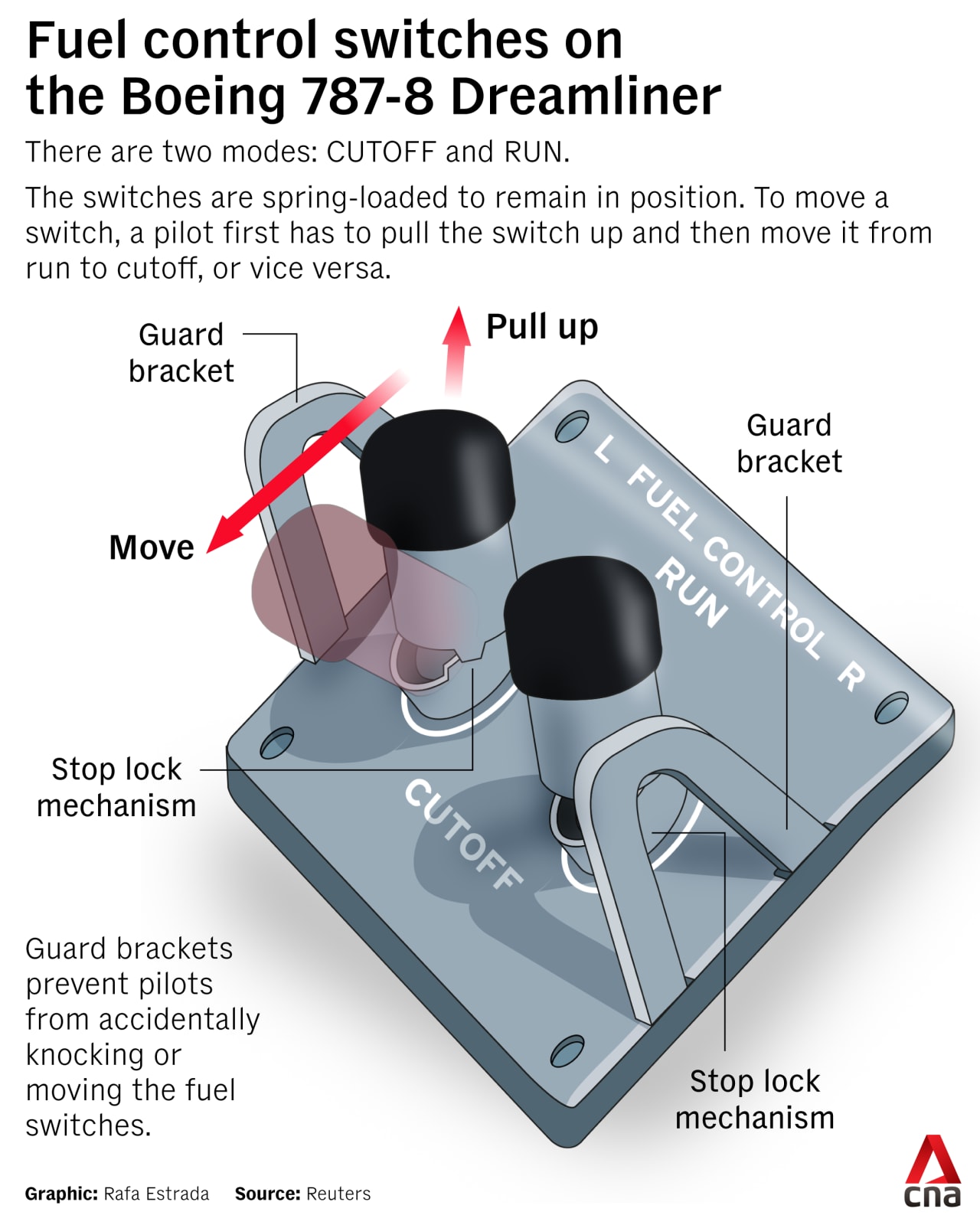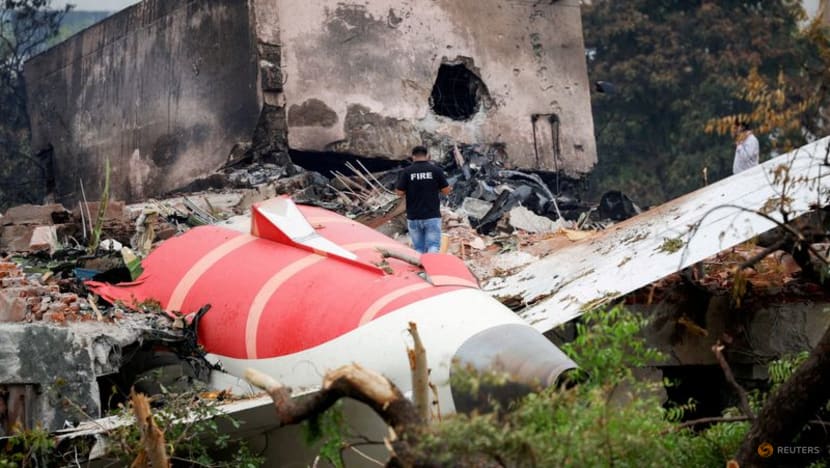Pilot error or technical fault? Air India crash report deepens mystery of fuel supply cut
The preliminary report has put the spotlight on the Boeing 787-8 Dreamliner fuel control switches.

Pictures of Flight AI171's thrust lever quadrant and fuel control switch that were provided in a preliminary report released on Jul 12, 2025. (Photos: Preliminary report on Air India's B787-8 aircraft crash)

This audio is generated by an AI tool.
SINGAPORE: Air India flight AI171 crashed in June because the plane's fuel control switches were moved to cut-off position, starving the engines of fuel, according to a preliminary report on the deadly disaster.
The report explains why the Boeing 787-8 Dreamliner went down moments after taking off from Ahmedabad airport. But it raises questions as to how the fuel supply to both engines could have been cut off, given the design of these controls.
In a cockpit voice recording, one pilot is heard asking the other why he flipped the switches. The pilot responds that he did not do so. The plane was seen losing altitude.
Seconds later, the fuel switches were flipped to turn the fuel supply back on. But it was too late to stop the plane's descent.
It crashed into a medical college hostel, killing all but one of the 242 people on the plane.

The preliminary report, issued by India's Aircraft Accident Investigation Bureau on Saturday (Jul 12), showed that the crash was unlikely to have been caused by pilot error, said aviation experts.
Fuel control switches are not like light switches, which can be turned off and on accidentally when you hit them, Mr Chow Kok Wah, a former airline executive in aircraft maintenance, told CNA.
“It's a metal switch with a knot sticking out. You have to pull the switch and lift it up over a metal obstacle, and then release it back in,” he explained.
“There’s no way that you can accidentally knock it and then it goes in the opposite direction.”

Mr Eshan Khalid, a former pilot and aviation expert, told Reuters “deliberate action” was needed to move the fuel control switches.
The pilot’s exchange in the audio recording also showed that there were attempts to move the switch back to "run" mode.
“From the findings, it tells me that it wasn't pilot error,” said former pilot Marco Chan, a senior lecturer at Buckinghamshire New University’s aviation school.
“And there's nothing, at least for now, for the time being, that points to a pilot error from the cockpit voice recorder. It appears they are trying to recover the flight from going down to the ground.”
Timeline of events
Here's a detailed timeline of what happened aboard AI171 moments before the crash:
7.55.15am GMT: The aircraft requested taxi clearance, which was granted by air traffic control. A minute later, the aircraft taxied from the bay to Runway 23 via Taxiway R4, backtracked and lined up for take-off.
8.02.03am: The aircraft was transferred from ground to tower control.
8.07.33am: Take-off clearance issued.
8.07.37am: The aircraft started rolling.
8.08.39am: Aircraft lifted off. "The aircraft air/ground sensors transitioned to air mode, consistent with liftoff," the report said.
8.08.42am: Aircraft reached max airspeed of 180 knots. "Immediately thereafter, the Engine 1 and Engine 2 fuel cutoff switches transitioned from RUN to CUTOFF position one after another with a time gap of 01 sec," the report said.
"The Engine N1 and N2 began to decrease from their take-off values as the fuel supply to the engines was cut off.
"In the cockpit voice recording, one of the pilots is heard asking the other why did he cutoff. The other pilot responded that he did not do so.
"The CCTV footage obtained from the airport showed Ram Air Turbine (RAT) getting deployed during the initial climb immediately after lift-off
"The aircraft started to lose altitude before crossing the airport perimeter wall."
8.08.47am: Both engines' values "passed below minimum idle speed", and the RAT hydraulic pump began supplying hydraulic power.
8.08.52am: Engine 1 fuel cutoff switch transitioned from CUTOFF to RUN.
8.08.56: Engine 2 fuel cutoff switch also transitions from CUTOFF to RUN.
"When fuel control switches are moved from CUTOFF to RUN while the aircraft is in flight, each engine's full authority dual engine control (FADEC) automatically manages a relight and thrust recovery sequence of ignition and fuel introduction," the report stated.
"Engine 1’s core deceleration stopped, reversed and started to progress to recovery. Engine 2 was able to relight but could not arrest core speed deceleration and reintroduced fuel repeatedly to increase core speed acceleration and recovery."
8.09.05am: One of the pilots transmitted “MAYDAY MAYDAY MAYDAY".
8.09.11am: Data recording stopped.
8.14.44am: Crash fire tender left the airport premises for rescue and firefighting.
“TRICKY THING”
Mr Chan told Reuters that the report pointed to a chip malfunction.
He believes the cutoff came from an error with the chip, for which the engine manufacturer previously issued a service bulletin advising maintenance in order to prevent signal loss.
"Once you have a loss of signal, the fuel isn’t commanded, ... then there's no fuel going to the engine, which seems to have matched what the service bulletin was saying with this current investigation," said Mr Chan.
However, Mr Chow said a chip malfunction was “very unlikely”.
The fuel control switches are a very crucial function in the operation of a plane, and whoever designed them would have thought of all these possibilities, he added.
“(They) would not have designed it in a way that a malfunction could cause the engine to shut down, because it's a very, very serious matter,” said Mr Chow.
“And the fact that it happened to two engines almost simultaneously would put the probability at near zero.”
He also noted that, according to the report, the engines had responded positively after the pilots noticed the switches’ position and changed them back.
“If it were a malfunction, would it come on again? Both of them?” he asked. “It’s very, very, very unlikely.”
Asked what else could have caused the switches to move, Mr Chow said it was a “tricky thing”.
“All we can say is somebody operated the switch. It will not move on its own.”
Warning against speculation that the pilots could be responsible, Mr Khalid raised the possibility that some clarification might be needed from the Aircraft Accident Investigation Bureau as an explanation.
It is not clear from the short exchange between the pilots if they were referring to the switch position or the engine states. Their exact words were not stated in the report, which summarises the events.
“Maybe it (the bureau) will clarify in due course of time that it was not the fuel cutoff switch, but the fuel shutoff valve that probably switched off while the fuel cutoff switch continued to remain in its position," Mr Khalid suggested to Reuters.
REPORT GIVES BASIC INFORMATION
The preliminary report found no mechanical or maintenance faults on the Air India Boeing Dreamliner, and that all required maintenance had been carried out.
Asked if there should be more checks on fuel control switches given the lack of answers on how the controls moved, Mr Chow pointed out that the authorities and manufacturers had not yet issued any guidance.
There has been no factual evidence to support the conclusion that immediate action was needed to be taken on similar planes, he added.
Mr Chow also noted that in aviation investigations, the preliminary report only serves to provide the public with some basic facts to prevent unnecessary speculation.
Now that the report has been released, a more thorough investigation will take place before a final report, he said.
The authorities and manufacturers will likely look at the plane’s engine start system once more.
“A month is a bit hard for them to do all that stuff,” Mr Chow said.
Should they find nothing, the investigators will then look at other possibilities, such as the background and behaviour of those in the cockpit, he added.
"Now the focus is entirely on the start switch. And if the start switches are working properly, then it must be (that) somebody moved it,” he said.
“Who, is the question.”
Air India CEO Campbell Wilson said in an internal memo on Monday that the probe into the crash is "far from over". He added that the airline is open to further inquiries and warned against "premature conclusions".
The memo said the preliminary report found no mechanical or maintenance faults and that all required maintenance had been carried out.
ALPA India, which represents Indian pilots at the Montreal-based International Federation of Air Line Pilots’ Associations, has rejected any presumption of pilot error and called for a "fair, fact-based inquiry".
"The pilots had passed their mandatory pre-flight breathalyser and there were no observations pertaining to their medical status," Campbell noted in his memo.
The Indian Commercial Pilots Association also said it was "deeply disturbed by speculative narratives ... particularly the reckless and unfounded insinuation of pilot suicide".
"There is absolutely no basis for such a claim at this stage," it said in a statement on Sunday, adding, "it is deeply insensitive to the individuals and families involved".
















